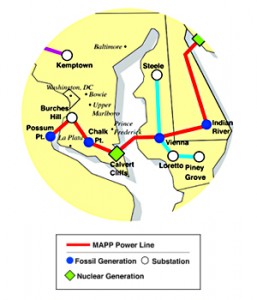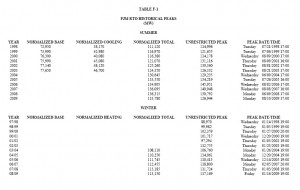Park Service releases EIS Scoping Report
April 29th, 2010
Imagine 190 foot transmission towers through the Delaware Water Gap, between Pennsylvania and New Jersey.
That’s what’s proposed by PSE&G for its Susquehanna-Roseland transmission line. This quad/tri bundled 500kV line is HUGE, ugly beyond belief, and it’s just so big that I can hardly comprehend, there’s nothing that large that I’ve found. Others like it are being cancelled by PJM due to lack of demand, and this one should be too…
From the Pocono Record:
Anyway, the National Park Service is doing an Environmental Impact Statement, and leading up to that is “scoping,” which, as Grant Stevenson noted yesterday at the Task Force meeting, is THE most misunderstood term. I agree. It just zooms over people’s heads, and comments end up being of the “I hate this project because___” and nothing that relates to what the scope of the environmental review should be. Utter waste of time, and something to be mindful of with the CapX 2020 transmission scoping meetings coming up.
SCOPE: Range, area of coverage, breadth
So “scoping” in this sense is the range, area of coverage, and breadth of environmental review.
We had comments on the scope a few months ago, and there were something like 6,500 comments. Yes, that’s right, SIX THOUSAND FIVE HUNDRED! At the meetings I went to, it was standing room only and the comments were notably on point, they were profound examples of those rare uplifting meetings. Facilitation of the meetings was so good it felt like they really were interested in what we had to say. It was all taken down by a court reporter. THAT level of attention and appreciation is SO rare… and dig this … afterwards I RECEIVED A THANK YOU NOTE FOR PARTICIPATING. That is a first, I’ve never gotten a thank you note from an agency for showing up and speaking out. I’m thinking of framing it (after sending it to MN’s Dept. of Commerce).
NATIONAL PARK SERVICE – SUSQUEHANNA-ROSELAND 500kV TRANSMISSION LINE PAGE
Here’s their report:
The next step?
We’ll keep you posted.
National Park Service extends Comment period
March 5th, 2010
National Park Service has extended the deadline for EIS Scoping Comments on the Susquehanna-Roseland transmission project. WHEW! Now we have until March 12 to send our comments in!
Get your clues on Comments from what they do and do not include:
It’s in the Pocono Times:
From the NPS blog:
Posted March 5th, 2010 by Kurt Repanshek
High public interest has prompted the superintendents of Delaware Water Gap National Recreation Area, the Appalachian National Scenic Trail, and the Middle Delaware National Scenic and Recreational River and National Recreation Water Trail to extend by a week the public comment period on a proposal to run a transmission line across the areas.
The comment period was scheduled to end today, but has been extended through March 12.
There are numerous ways for the public to provide comments on the public scoping phase of the planning process, including leaving a message on the Park Planning Information Telephone Line (570-426-2491), submitting comments online through a link on the National Park Service Planning, Environment and Public Comment site, http://parkplanning.nps.gov (select Appalachian NST or Delaware Water Gap NRA), or by mailing comments to:
Detailed information about the need for the EIS and the project timeline
can be found on the National Park Service Planning, Environment and Public
Comment site: http://parkplanning.nps.gov.
That line’s going to fall in my living room…
January 24th, 2010
MID-Atlantic Power Pathway and all of PJM’s “backbone” projects in the news:
She’s worried about a larger line rising in the shadow of her house. If the poles somehow get knocked over, “Where’s that line going to fall? That line’s going to fall in my living room.
That’s Farah Morelli’s question. She’s a regular person who woke up one day with a monstrously large transmission line planned literally in her back yard. That’s usually the most effective way to get someone to learn about transmission. It’s a steep learning curve, and what I’ve found in my work with people in the path of proposed transmission is that once they start looking, they find a disturbing fact: Utilities propose transmission lines not because they’re “needed” but that they’re wanted, wanted to increase their ability to transmit and SELL cheap power in areas where it’s higher cost, and make a bundle in the process. It’s not that people don’t have electricity (and high price is the best instigator of conservation), but it’s that people want more and want it cheaper and the utilities which make $$$ from that equation want to make it happen.
HERE’S THE REALITY — The PJM 2010 Load Forecast Report and the Monitoring Analytics “PJM 3Q State of the Market” report show that this market decline isn’t anything new and that it’s not going away anytime soon. The PJM market peaked in 2006:
Today’s News Journal article is a start at pulling it all together, taking a look at the bigger picture, and that bigger picture is what these transmission lines are all about. Three lines were proposed together, the Potomac Allegheny Transmission Highline (PATH), the Mid-Atlantic Power Pathway (MAPP) and the Susquehanna-Roseland line. These aren’t just transmission lines, they’re BIG HONKIN’ ELECTRICAL AUTOBAHNS, quad (or now maybe tri?) bundled 500kV lines. Like WOW. HUGE!
Here’s today’s article:
Lower energy projections put brakes on power lines
Susquehanna-Roseland delay in the news
January 16th, 2010
Here are the articles on the NJ BPU delay of decision on Susquehanna-Roseland transmission line, but before that, here’s the letter the BPU sent to PJM requesting more information based on yesterday’s decision to put on the brakes:
Color me jaded, but what is needed is what Stop the Lines requested in our STL – Reply Brief, based on the sensitivity analysis ordered for PATH:
• PSE&G must waive any claim to FERC “backstop” authority in the pendancy of this sensitivity analysis and Board deliberation.
• The sensitivity analysis must include, but is not limited to those scenarios Ordered in the PATH docket:
1. Susquehanna-Roseland load flow analyses updated to reflect the following changes in generation: (i) all existing generation as of January 7, 2010, which is not scheduled to be retired before 2014; (ii) all proposed generation that cleared the May 2009 PRM Auction; and (iii) all proposed generation with a signed ISA as of January 7, 2009 (“Scenario 1 generation”);
2. Susquehanna-Roseland load flow analyses updated for the changes in Scenario 1 generation, and updated to reflect PJM’s 2010 load forecast (“Scenario 2”);
3. Susquehanna-Roseland load flow analyses updated for the changes in Scenario 1 generation, and updated to reflect the demand response and energy efficiency resources that cleared the May 2009 RPM Auction;
4. Susquehanna-Roseland load flow analyses updated for the changes in Scenario 1 generation, and PJM’s 2010 load forecast (i.e., Scenario 2) and updated to reflect the demand response and energy efficiency resources that cleared the May 2009 RPM Auction;
5. Susquehanna-Roseland load flow analyses updated for the changes in Scenario 1 generation, PJM’s 2010 load forecast, and to reflect the demand response and energy efficiency resources that cleared the May 2009 RPM Auction (i.e. Scenario 4), and updated to reflect the forecasted additional demand response and energy resource reasonably available for 2014, 2015 and 2016 (i.e. using MW from PATH of 367, 420, and469 respectively); and
6. Susquehanna-Roseland load flow analyses updated for the changes in Scenario 1 generation, PJM’s 2010 load forecast, the demand response and energy efficiency resources that cleared the May 2009 RPM Auction, the forecasted additional demand response and energy resource reasonably available for 2014, 2015 and 2016; and updated to reflect additional demand response and energy efficiency projected (i.e. using MW from path of 1,825, 2,140 and 2,403 respectively).
These results shall be distributed to the parties as soon as possible and shall be subject to limited discovery and cross examination, after which the Board shall consider them together with the balance of the record in this matter.
See why it’s frustrating — they just missed the boat completely with the vague request to PJM…
So, on with the press coverage about yesterday’s decision to delay:

New Jersey regulators delay decision on PSEG transmission line
By Mark Peters
Of DOW JONES NEWSWIRES
Public Service Enterprise Group shares were at $32.32, down 50 cents, or 1.5%, in recent trading.
-By Mark Peters, Dow Jones Newswires; 212-416-2457 mark.peters@dowjones.com
================================================================
Decision delayed on power project
Saturday, January 16, 2010
Lawrence Ragonese
STAR-LEDGER STAFF
Lawrence Ragonese may be reached at (973) 539-7910 or lragonese@starledger.com
===============================================================
State officials delay decision on PSE&G powerline for a month
By COLLEEN O’DEA • STAFF WRITER • January 16, 2010
Karen Johnson, a PSE&G spokeswoman, said the utility was discouraged by the delay.
Colleen O’Dea: 973-428-6655; codea@gannett.com.
===============================================
Susquehanna-Roseland line approved with conditions in Pennsylvania; New Jersey vote is delayed
DELAY — Susquehanna-Roseland live from the BPU
January 15th, 2010
Fur was flying last night, late when I got a chance to check in, whew…
I’ll be typing notes as we go… we’ll see.
The room is filling up, almost standing room only…
I’ll correct all the typos later…
January 15, 2010
Pledge of allegiance
All five present
Next meeting 1/20 @ 10 a.m.
Special meeting regarding Petition of PSEG re Susquehanna-Roseland line
Ken Sheehan – background – description of project
Jurisdiction
Cost – portion for NJ ratepayers not clear, open issue at FERC
PSE&G claims must be in service by 2012
Extremely complicated
Key questions – need for the project, specifically to resolve reliability problems
Oct 15 2009 – PJM reaffirmed need for PATH, MAPP and S-R
Board became aware of changes in need for PATH line – VA-PATH has asked for withdrawal. Reduction in scope and severity of NERC violqations, PJM will work through planning process
This has raised issue of similar issues with this line
Fiordaliso gave official notice to these issues. PSE&G did not object to entry
Firodaliso also gave official notice re: MAPP suspension. MAPP – PJM said it needed to reanalyze need for MAPP because it assumed PATH
There has been a flurry of comments regarding official notice these last few days. Most notably was two paragraph letter from PJM witness – delays will not in any way change the need for Susquehanna-Roseland.
Intervenors have noted that this conclusory statement needs substantiation.
Fiordaliso has formally recommended that the Board take notice of PATH and MAPP.
Firodaliso – (these guys are talking way too fast)
One word that soood out was flurry. I was the prsiding commissioner. During the proceedings we have held multiple public eharings, held a full evidentiary hearing. We have provided opportunities to prepare Pos Hearing briefs, filed only on 1/6/2010. It was inthese briefs that the PATH and MAPP issues were first raised. Because of the importance of this issue, I felt it was appropriate to bring this to the full Baord. My immediate question, shared by the other commissioners, is whether this information has the ability to significantly change the underlying factual situation of these lines. If PJM is no longer certain that MAPP and PAH are no longer needed at this time. I believe our board would be remiss not to consider whether PJM would feel the same about S-R and how that would affect NJ. The changes to PATH aned MAPP are extraordinary, this is not minor updates and changes (Comm. Fox nods vigorously). One of the core analyhsis of this is need, are the lines needed for the protection of transmission. PJM is able to provide expert analysis. The board would be remiss in not taking this into consideration. PJM has sent a letter that nothing ash changed. (quoting from PJM letter, above is link) “For clarity and in order to avoid any confusion, PJM as the independent transmission authority, that the factors driving PATH and MAPP do not in any way change need for S-R in NJ as detailed in my testimony as set forth in this docket.” We appreciate that input, nevertheless we need more than a this suumary statement. We need to have PJM to explain how they reached that conclusion, and in a way that will allow all parties to comment.
Amend recommendation — recommend to Board that we issue secretary’s letter to PJM asking for their input, notably we should seek and receive detailed confirmation that despite changes in map and path lines no changes have occurred in its analysis tof SF that would materially alter PJM analysis. provide this as soon as possible to allow for our review and provide opportunities for all parties in this case to see the results. This will allow the board to make an informed decision.
I do not want anyone to have the opinion that the board will issue a decision today. One of the obstacles is that the Board may need additional facts, and this is where we currently find ourselves.
Everyone associated with this project has been working as hard as humanly possible to bring this to an efficient and proper conclusion. The size of the record and the significance of this case make it essential that the Commission have a full record and the depth of understanding to understand the positions advanced by all of the parties. This always takes time, with a record as voluminous and contested as this. I hope we can get a commitment from all the commissioners, we can get a commitment to have a decision within 30 days. This time-frame represents a fair balancing of the Board’s responsibilities and the Board’s desire to have this as fair as possible.
Butler:
In my 11 years as commissioner, I’ve learned a few things. Transmission cases are never easy. I also know that I have rarely seen a record this large and with this many parties, and I’ve never seen it decided just 7-8 days of receipt of final briefs. The size of the record, the need to reach a decision, we will give commitment to render that decision. I will be spending part of my holiday reviewing this case! We need to balance needs of community and its residents, take the time, that’s correct approach.
PSEGE called me and informed me Ex PARTE , others commissioners were contacted as well. (all were nodding at this statement). I believe our course of action is the correct one. Asking PJM for formal communication as to how they reached their decision, I am confident it will be a better decision because of the steps we’ve taken today.
Asselta:
I am also in agreement with the presiding Commissioner. I have to tell you that I have not been contacted by any parties. I know a few things that I’m in support of, improving reliability, making sure we have complete reliability, and besides that, economic opportunities, infrastructure improvement so state can grow, I am looking forward to the 30 day deadline, so that the state of NJ will come to conclusion on this decision. I too am looking forward to the reports, make sure this is the right project at the right time and that the ratepayers are not on the hook for every bit of the cost to produce this line. I am in support of Commissioenr Fiordaliso’s request.
Randall:
I agree, I am not prepared to cast vote on this today based on volume of information. I do believe that I will be prepared within the next 30 days.
Fox:
I want to thank follow commissioners and staff for work and thanks to Commissioner Fioredaliso. I’m in strong agreement with Commissioners, record is huge, the transcript is almost 1200 pages, in past , the government has to strive to get it right, for the state and people we represent. Good government requires we take notice of these developments and consider changes in transmission system, failure would be failure to do our jobs correctly. We are not ready to make decision at this time, we just closed record a week ago, and there are significant issues to get into, whether need has evolved, this is not a simple matter, it is not obvious. Resonable minds can and have differed, I’m aware PSEG has a construction schedule, but I am confident that this will not impact their schedule. I’m aware that there’s a FERC deadline, but I believe this action is necessary and propery. We can make this decision within a month. We can maek a final determination in the meantime.
Fiordaliso:
I make a motion, take judicial of information as outlined, and a secretary’[s letter be sent to PJM seeking additional information
Butler:
I second that.
Randall:
I also want to note that we are refirming Commissioner’s 30 day deadline.
Passed unanimously.
++++++++++++++++++++
Here’s the letter they sent, missing the boat…



